Key takeaways
💡 AI tools for UX research can enhance data processing, enabling researchers to quickly identify patterns and actionable insights from datasets to streamline the research process.
📊 By leveraging AI for user segmentation, researchers can create more targeted and personalized experiences based on user behaviors and preferences, leading to more intuitive product designs.
🔍 AI Tools have the capacity to automate usability testing, helping researchers identify pain points without the need for extensive manual testing.
📈 They also allow for scalable research capabilities, making it easier to conduct tests with thousands of users across diverse demographics simultaneously.
In just a few years, AI tools have become increasingly integral to UX research, enhancing various aspects of the process from data collection to actual analysis.
As the field grows more data-driven, AI’s ability to process vast amounts of information in real-time is key to unlocking deeper user understanding. From automating data analysis to personalizing digital customer experiences, AI enables UX researchers to work smarter and faster.
As these tools continue to evolve, they offer UX researchers not just efficiency but also the ability to deliver more personalized and intuitive experiences. This article will explore the best AI tools available for you to enhance your UX research workflow.
There is some concern that AI will start replacing UX researchers. However, most professionals feel that it’s not the case. Rather, they believe that AI will become a good useful tool that will help streamline the UX research process. Åsa Andersson, a CX strategist, assessed the situation aptly:
There’s a considerable amount of skepticism surrounding AI and its potential impact on our lives. Only time will reveal the full picture, but I’m optimistic about the positive changes it will bring.
In this domain, there is a variety of different tasks for which AI UX research tools can be leveraged. Most commonly though, their key applications include these areas:
Data collection and Transcription
One of the most common uses of AI in UX research is for data analysis and insights generation. AI can sift through large sets of qualitative and quantitative data, identifying patterns and trends that could otherwise go unnoticed.
From providing transcriptions for audio and video recordings to streamlining the data collection process, you can use AI-powered tools for all of your knowledge management purposes – hence improving collaboration among your stakeholders.
User Segmentation
Another key area where AI shines is in user segmentation and personalization. UX researchers can leverage AI to group users based on shared behaviors, demographics, or preferences, leading to more targeted and personalized experiences.
This can make your product designs and interfaces not only more intuitive but tailored to the specific needs of different user groups.
Usability Testing
Besides data collection and segmentation, AI is also increasingly being used for usability testing. Traditionally, usability testing requires real users to interact with a product. However, AI tools can be used to simulate these interactions, automatically identifying potential pain points or areas for improvement.
For instance, AI tools can help you simulate user interactions, generate heatmaps and click tracking reports, automate feedback, perform user flow analyses and much more.
Prototyping
Besides the areas mentioned above, these tools are increasingly being used for prototyping and design assistance – from suggesting layouts and recommending component placements to even generating wireframes based on user data.
Using them for this purpose can really accelerate your design process and allow your team to focus more on strategy and less on repetitive tasks. Furthermore, some tools can streamline workflows even more by auto-generating variations of a design for A/B testing.
When implemented correctly, augmenting your workflow with AI tools can make your research process smooth like honey. 🍯
Interested in conducting your research? Try it now by registering for your free account or booking a demo call, and you’ll be all set for the upcoming months.
As our digital products grow in complexity, understanding how users interact with them is crucial for creating seamless, user-friendly experiences. Here are some benefits of leveraging AI UX research tools in your next research:
Faster Data Analysis and Processing
One of the most significant benefits of using AI in UX research is the speed at which it can process and analyze data. Traditional UX research often involves manually sorting through large amounts of user data, whether it’s survey responses, usability testing results, or analytics from product interactions.
As you can imagine, this can be time-consuming – especially with larger user groups. AI tools, however, can quickly process and analyze this data, extracting patterns, trends, and actionable insights in a fraction of the time.
For instance, AI can assist in moderated testing by grouping similar feedback, detect recurring issues, and generate summaries of user pain points. It can even process complex behavioral data like clickstreams, scroll patterns, and navigation paths, helping you faster identify areas for improvement and usability bottlenecks.
2. Deeper Behavioral and Emotional Insights
Besides the advantages of analyzing and extrapolating data, using AI tools in your research can help you conduct a behavioral and emotional analysis that goes beyond what you might achieve using traditional methods.
By leveraging AI in User Research, you can not only analyze your users’ behavioral patterns more effectively but also easily conduct a sentiment analysis to see how they feel about it. For example, you can use it to track user behavior on a granular level, such as how long a user hovers over a specific button, the sequence of clicks they follow, or how quickly they complete tasks.
Additionally, AI-powered sentiment analysis tools can interpret emotional responses in user feedback, such as identifying frustration, satisfaction, or confusion based on the language used in surveys, reviews, or social media comments.
Some AI systems can even analyze facial expressions, vocal intonations, or body language in mobile usability tests to detect emotional reactions. Utilizing this technology can provide you with rich, nuanced insights into both the cognitive and emotional dimensions of UX and help you design a more empathetic, user-friendly product.
3. Scalability and Remote Research
Another benefit of AI tools for UX is their ability to scale your research to levels that are difficult to achieve with traditional methods. When conducting usability tests or gathering user feedback manually, it’s often challenging to reach large, geographically diverse user groups without significant time and resource investments.
AI UX research tools can run tests with thousands of users across different regions simultaneously, analyzing the data in real time without requiring additional human effort.
From recording user sessions to tracking interactions, the ability to automatically analyze behavior from a distance can save you a lot of time. This is particularly useful in today’s global, remote-first environment, where it’s crucial to understand how products perform across various demographics, locations, and devices.
You can use their scaling abilities to obtain insights from diverse user bases, leading to cost-effective designs that cater to a wide array of users while maintaining efficiency.
|
|
Rating |
Overall score |
Pricing |
|
UXtweak |
4.9/5 |
✓ Free plan Starts at 99€/month |
|
|
Looppanel |
4.9/5 |
✗ No free plan Starts at $27/month |
|
|
Sprig |
4.6/5 |
✗ No free plan Starts at $175/month Also billed annually |
|
|
Maze |
4.1/5 |
✗ No free plan Starts at $75/month |
|
|
ChatGPT |
4.6/5 |
✓ Free plan Starts at $20/month Also billed annually |
|
|
NotionAI |
4.7/5 |
✓ Free plan Starts at $10/monthAlso billed annually |
|
|
Extellio |
4.3/5 |
✗ No free plan Starts at $30/month |
|
|
Claude.ai |
4.6/5 |
✓ Free plan Starts at $20/month Also billed annually |
|
|
Perplexity.ai |
5.0/5 |
✓ Free plan Starts at $20/month Also billed annually |
|
|
Copy.ai |
4.1/5 |
✓ Free plan Starts at $49/month Also billed annually |
|
|
Make Opinion |
4.7/5 |
✗ No free plan Custom – usage based |
|
|
UserEvaluation |
n.d. |
✓ Free plan Starts at $20/month Also billed annually |
|
|
Research Studio |
4.6/5 |
✓ Free plan Starts at $35/month Also billed annually |
|
|
Uizard |
4.3/5 |
✓ Free plan Starts at $12/month |
|
|
Lookback |
3.0/5 |
✗ No free plan Starts at $17/month |
|
|
Dovetail |
4.5/5 |
✓ Free plan Starts at $29/month Also billed annually |
|
|
Survicate |
4.6/5 |
✓ Free plan Starts at $99/month |
|
|
Lookback |
3.5/5 & 2.1/5 |
✗ No free plan Starts at $25 per month, billed annually |
|
|
Dovetail |
4.5/5 & 4.6/5 |
✓ Free plan Starts at $39/month |
|
|
Product Fruits |
4.7/5 |
✓ Free plan Starts at $99/month |
|
|
Optimal Workshop |
4.4/5 |
✗ No free plan Starts at $99/month |
|
|
Pendo |
4.5/5 |
✓ Free plan Custom pricing |
|
|
UserZoom |
4.4/5 |
✗ No free plan Custom pricing |
|
|
Startquestion |
4.9/5 |
✓ Free plan Starts at $79/month Also billed annually |
|
|
EnjoyHQ |
4.8/5 |
✗ No free plan Starts at $200/month per feature Also billed annually |
|
|
Smartlook |
4.7/5 |
✓ Free plan Starts at $55/month Also billed annually |
|
|
Hotjar |
4.7/5 |
✓ Free plan Starts at $39/month Also billed annually |
Note: reviews were taken from Capterra
1. UXtweak
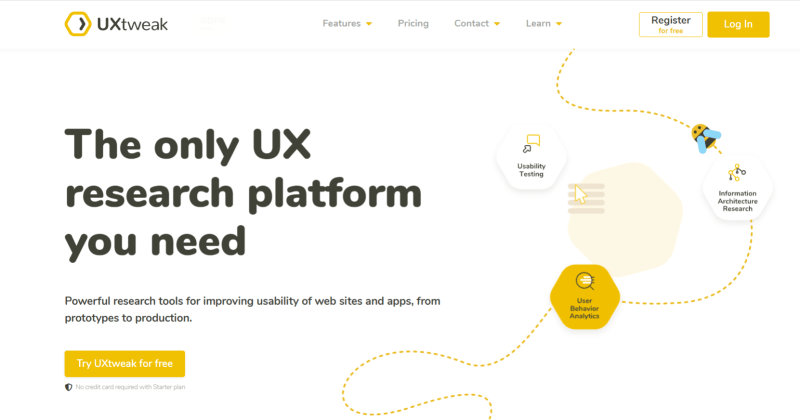
UXtweak is an all-in-one UX research platform that combines a wide suite of tools including AI-powered transcriptions, Website Testing, Session Recording, Card Sorting, Tree Testing, and Mobile Testing. It enables you to recruit, schedule, conduct, and analyze user interviews or any other moderated studies directly within the platform.
With capabilities to support nearly any research method, UXtweak offers advanced analytics and user recruitment options, making it ideal for gathering real user insights at any stage of development. The platform is user-friendly, designed to be easily navigable, ensuring you have everything needed for effective UX research.
Pros:
- UXtweak allows you to do as many usability tests as you like.
- For smaller tasks, there is a free plan available, or you may design a custom plan to meet your needs.
- Even a total newbie will find it simple to use.
- It provides powerful analytics that are simple to understand and digest into actionable insights.
Cons:
- It takes time to get used to the dashboard, but it gets easier with practice.
- UXtweak note: To address this, new tutorial videos are being produced.
Reviews according to Capterra:
Overall score – 4.9/5
Ease of Use – 4.8/5
Customer Service – 5/5
Pricing
UXtweak offers a free starting plan that includes an unlimited number of live studies and no study time restrictions, making it ideal for smaller research projects.
You may also choose between Plus plan aimed at solo researchers for $49 per month (annual billing) or a Business plan with up to 11 seats. If that is not enough, you can get your custom Enterprise plan tailored to your specific requirements. 🐝
2. Looppanel
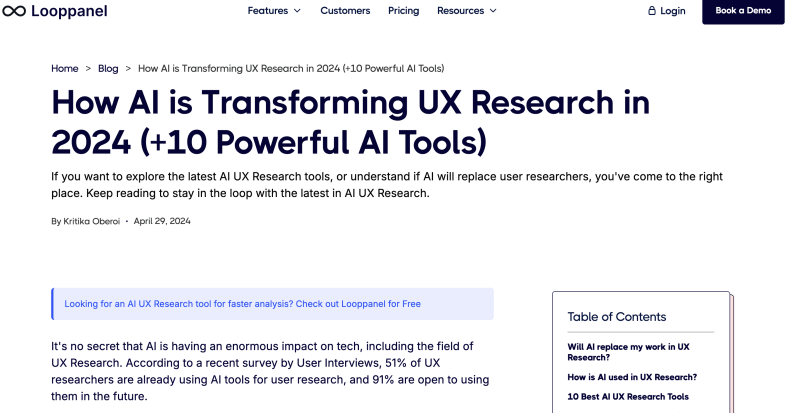
Looppanel is an AI-driven tool designed to streamline the process of UX research, particularly in user interviews. It provides an automatic transcription and analysis of interviews and usability tests, enabling UX teams to extract insights more quickly and efficiently. The tool helps users capture interview recordings, automatically transcribe conversations, and generate key video clips for presentations or reports.
Pros:
- Transcription & analysis
- Collaboration features
- Integration-friendly
Cons:
- Steep learning curve
- Limited customization
- Slower performance with large datasets
Reviews according to Capterra:
Overall score – 4.9/5
Ease of Use – 4.7/5
Customer Service – 4.8/5
Pricing:
Starts at $27 / month
3. Sprig
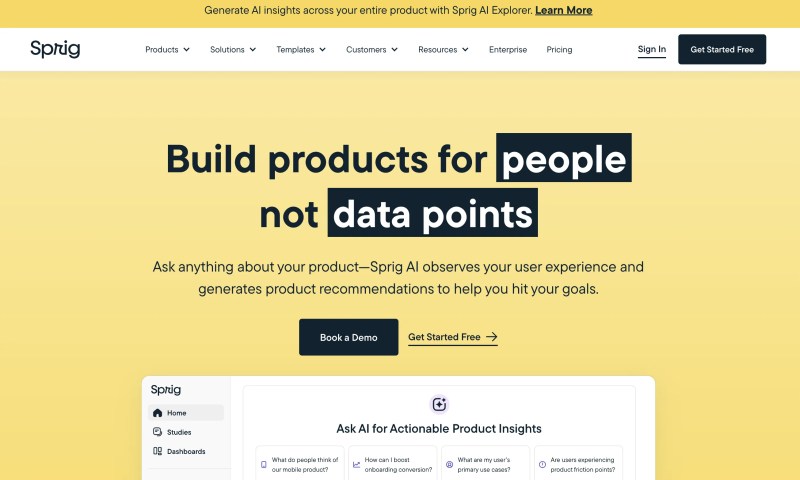
Sprig is a user insights platform that empowers product teams to build products with rich and rapid user insights. It provides user research technology that helps research and product teams learn from their customers in real-time and deliver product experiences.
Pros:
- High-touch support team
- AI-supported data analysis
- Easy-to-use
Cons:
- Survey limit allowance confusion
- Lacking customizable views of charts
- Price
Reviews according to Capterra:
Overall score – 4.6/5
Ease of Use – 4.7/5
Customer Service – 4.5/5
Pricing:
Free trial, starts at $175 / month
4. Maze
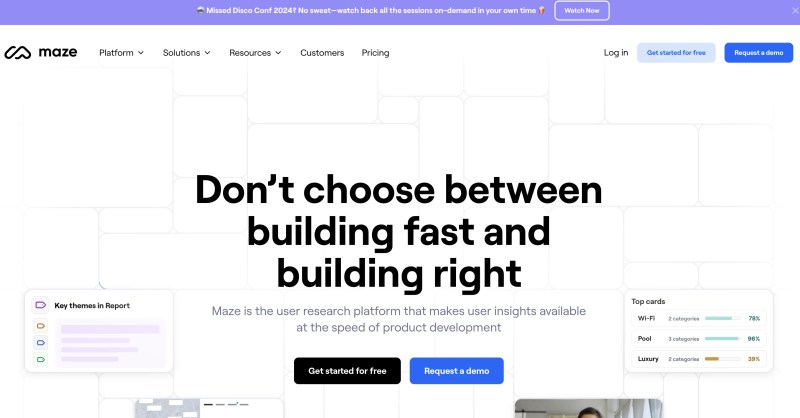
Maze is a remote user testing and rapid prototyping platform designed for UX and product teams. It allows users to create usability tests, collect user feedback, and analyze results without needing to code. The platform is used to gather actionable insights quickly, facilitating data-driven design decisions and enhancing the overall user experience of digital products.
Pros:
- Diverse testing options
- Integration capabilities
- Rapid feedback
Cons:
- Limited advanced features
- Steep learning curve for advanced use
- High cost for full features
Reviews according to Capterra:
Overall score – 4.1/5
Ease of Use – 4.3/5
Customer Service – 3.8/5
Pricing:
Starts at $75 / month
5. ChatGPT
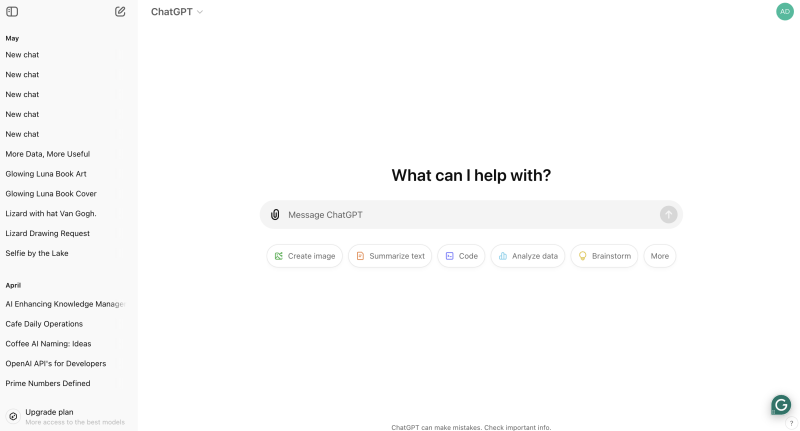
ChatGPT is a natural language processing tool that leverages AI functionality and helps users converse with chatbots like humans. The software allows users with tasks like writing essays, emails, poems, and code by responding to queries and requests in a manner reminiscent of a human being.
Pros:
- Versatile communication
- Customizability
- Ease of use
Cons:
- Limited accuracy
- Lack of deep understanding
- Privacy concerns
Reviews according to Capterra:
Overall score – 4.6/5
Ease of Use – 4.9/5
Customer Service – 4.1/5
Pricing:
Free, paid version starts at $20 / month
6. Notion AI
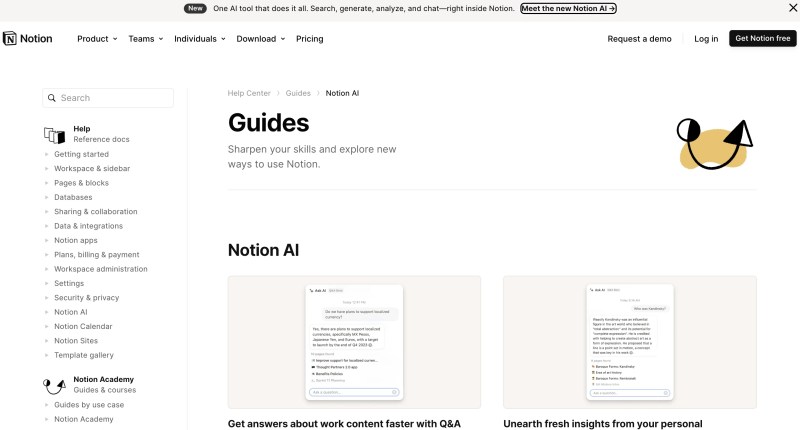
Notion AI is an integrated feature within Notion, a popular productivity and note-taking app. It uses artificial intelligence to assist users with writing, brainstorming, summarizing, and automating various content creation tasks to enhance productivity and workflow management.
Pros:
- Integrated workspace
- Content creation support
- Customizability
Cons:
- Limited creativity
- Data Privacy Concerns
Reviews according to Capterra:
Overall score – 4.7/5
Ease of Use – 4.6/5
Customer Service – 4.3/5
Pricing:
Free, paid version starts at $10 / month
7. Extellio
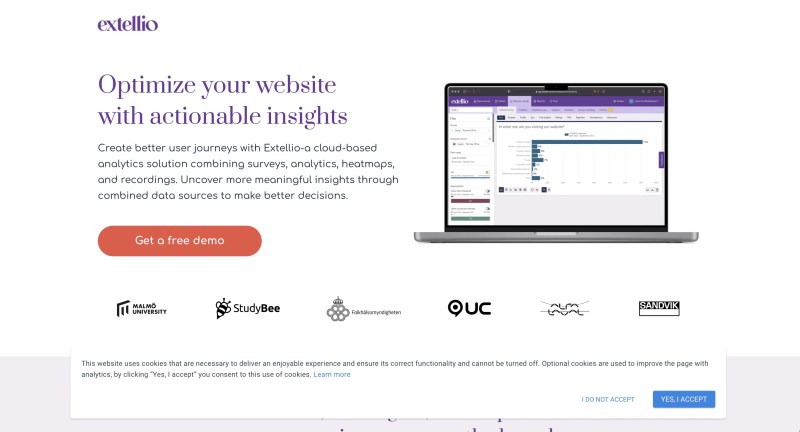
Extellio is a user research platform that integrates AI to help organizations understand user behavior and improve digital experiences. It uses AI-powered tools to analyze data from user interactions, providing insights into user needs, behaviors, and challenges. The platform is especially useful for UX research, helping streamline processes such as user surveys, heatmaps, session recordings, and analytics.
Pros:
- Enhanced data analysis
- Provides comprehensive insights
- Highly customizable
Cons:
- Steep learning curve
- Limited creative insight
Reviews according to Capterra:
Overall score – 4.3/5
Ease of Use – 4.3/5
Customer Service – 4.7/5
Pricing:
Starts at $30 / month
8. Claude.ai
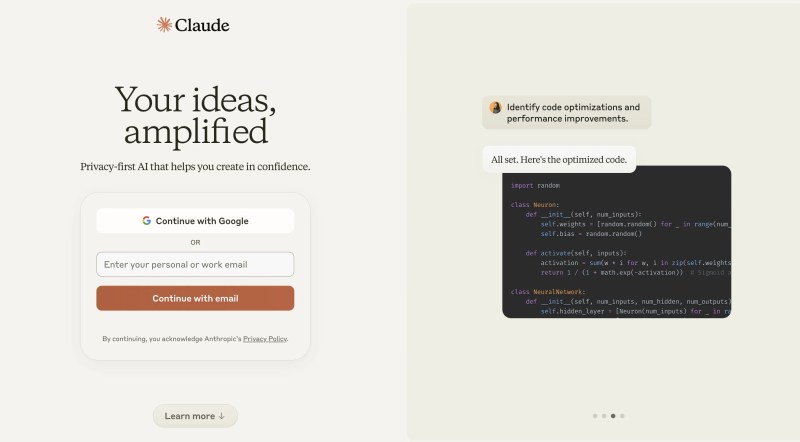
Claude.ai is an advanced AI chatbot developed by Anthropic that focuses on providing helpful and safe interactions. Named after Claude Shannon, a pioneer in information theory, the platform is designed to assist users across various applications, such as answering questions, providing explanations, and generating creative content.
Pros:
- Emphasis on AI use
- Versatility
- Continual improvement
Cons:
- Potencial for inaccuracy
- Lack of personalization
Reviews according to Capterra:
Overall score – 4.6/5
Ease of Use – 5.0/5
Customer Service – 3.7/5
Pricing:
Free, paid version starts at $20 / month
9. Perplexity.ai
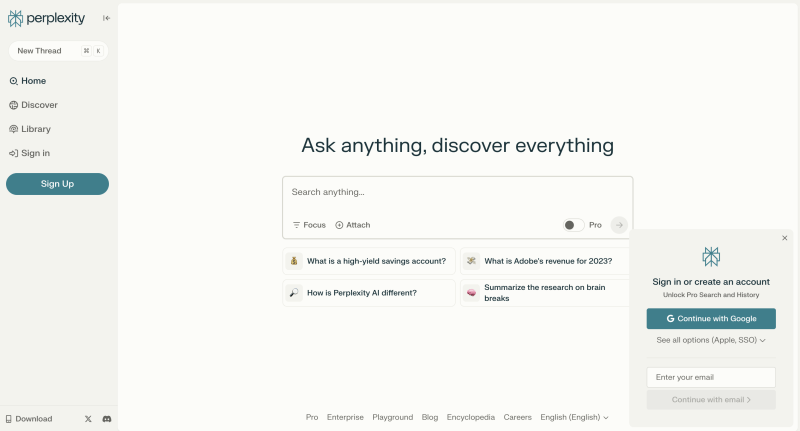
Perplexity AI is an advanced AI-powered search and conversational tool that combines large language model capabilities with search engine functionality to provide relevant, context-aware answers. Designed to enhance user inquiry experiences, it generates responses by sourcing information from multiple databases and references, ensuring that users receive concise, accurate, and evidence-backed answers.
Pros:
- High context-awareness
- Friendly user interface
- Provides sufficient resources when answering
Cons:
- Slightly limited in creative or open-ended tasks
- Reliant on internet data quality
Reviews according to Capterra:
Overall score – 5.0/5
Ease of Use – 4.8/5
Customer Service – 4.5/5
Pricing:
Free, paid version starts at $20 / month
10. Copy.ai
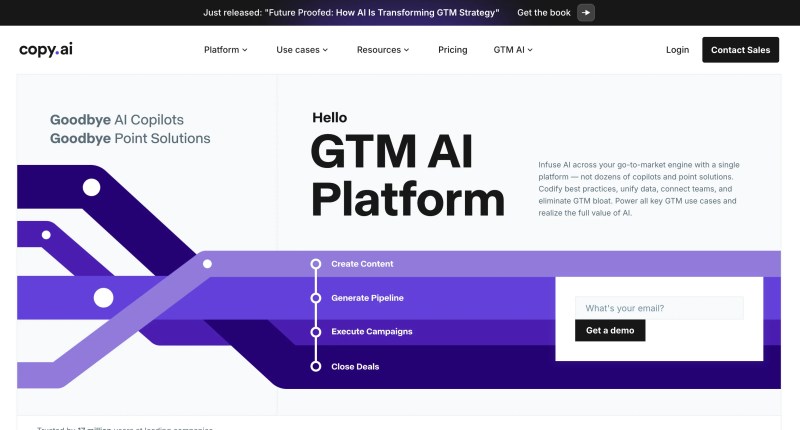
Copy.ai is an AI-powered content generation tool designed to assist businesses and individuals in creating high-quality written content quickly and efficiently. Leveraging advanced language models, it helps users produce various types of content such as blog posts, social media captions, emails, and product descriptions.
Pros:
- Ease of use
- Highly customizable
- Supports multiple content types
Cons:
- May struggle with nuanced topics
- Outputs may need significant editing
Reviews according to Capterra:
Overall score – 4.1/5
Ease of Use – 4.6/5
Customer Service – 4.2/5
Pricing:
Free, paid version starts at $49 / month
11. Make Opinion
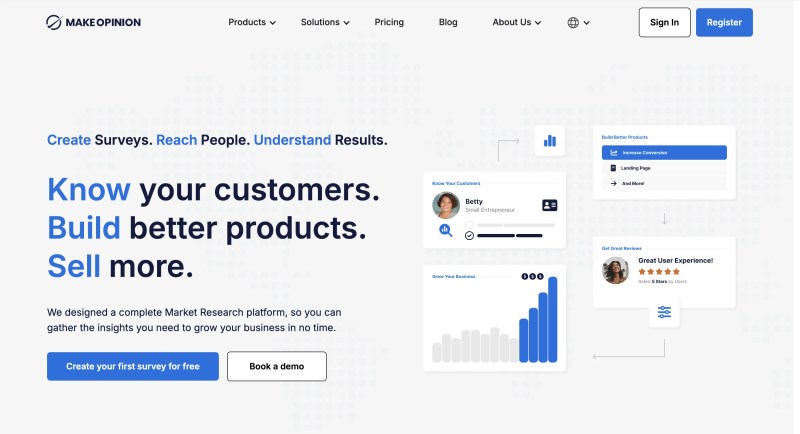
Make Opinion is an AI-powered tool designed to assist with real-time data collection and sentiment analysis, especially in customer feedback and social listening contexts. By analyzing user opinions, comments, and reviews, it allows businesses to understand consumer sentiments and emerging trends, using AI algorithms to quickly categorize and quantify emotional responses in large datasets.
Pros:
- Provides efficient sentiment analysis
- Customizable analytics
- Provides up-to-date feedback
Cons:
- Potential for bias
- Accuracy limitations
- Complex setup for customization
Reviews according to Capterra:
Overall score – 4.7/5
Ease of Use – 4.4/5
Customer Service – 4.6/5
Pricing:
Custom – derived from the number of surveys run
12. UserEvaluation
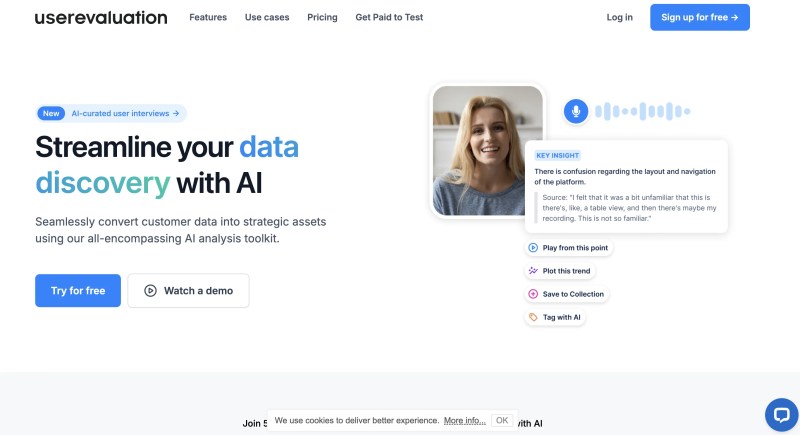
UserEvaluation is an AI-driven platform focused on helping companies and UX professionals conduct user testing and gather actionable insights. The tool supports various types of usability testing, such as remote user testing, surveys, and feedback collection, to improve user experience.
Pros:
- Supports multiple types of usability tests and surveys
- Suitable for different stages of product development
- Provides in-depth analysis of user data.
Cons:
- Substantial learning curve
- Customization limits
Reviews according to Capterra:
Overall score – n.d.
Ease of Use – n.d.
Customer Service – n.d.
Pricing:
Free, paid version starts from $20 / month
13. Research Studio
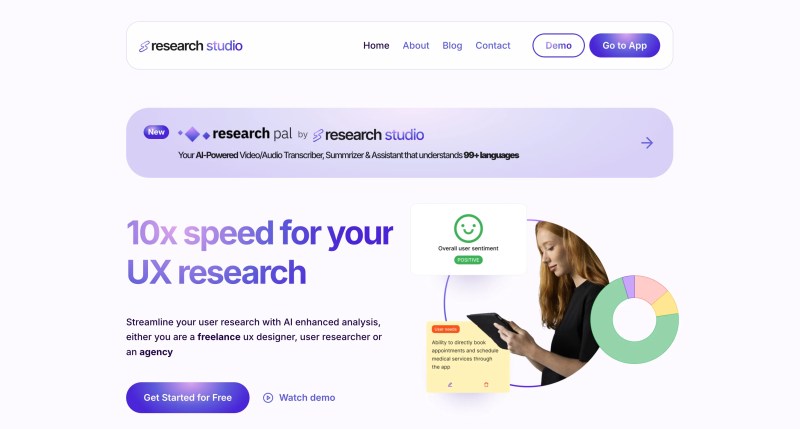
Research Studio is a platform designed for user research and UX testing, helping organizations gain insights into user behavior, preferences, and experiences. It offers tools to conduct interviews, usability tests, surveys, and task analysis, making it easier for researchers to gather both qualitative and quantitative data.
Pros:
- Provides multiple testing formats
- Suitable for remote and in-person testing
- Offers tailored reporting features
Cons:
- Steeper learning curve
- Limited in terms of integrations
- Heavy reliance on built-in analysis tools
Reviews according to Capterra:
Overall score – 4.6/5
Ease of Use – 4.1/5
Customer Service – 4.3/5
Pricing:
Starts at $35 / month
14. Uizard
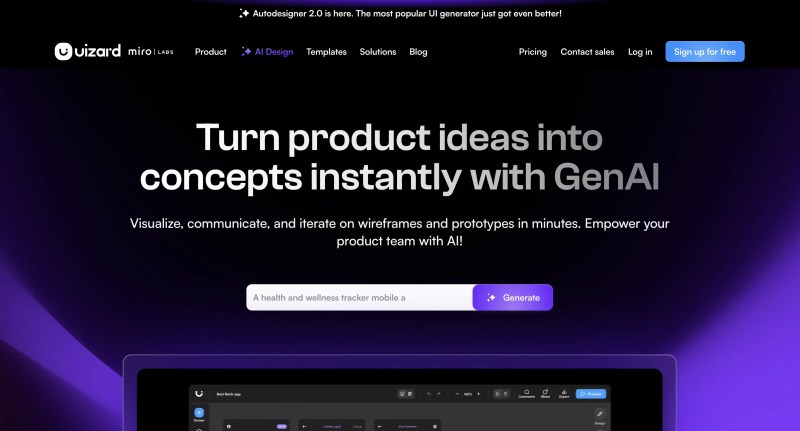
Uizard is an AI-powered design tool released in 2018. The platform’s easy-to-use drag-and-drop editor and its AI features help users design and prototype user interfaces for web and mobile applications. Although commonly deployed as a UI design solution, Uizard’s powerful AI capabilities can assist with a wide range of tasks from heatmap prediction, to text generation, and UI theme creation.
Pros:
- Supports cross-platform prototyping
- Offers customizable templates
- Solid set of AI features
Cons:
- Limited customization
- Performance lag on larger projects
- Restricted to prototyping
Reviews according to Capterra:
Overall score – 4.3/5
Ease of Use – 4.5/5
Customer Service – 4.7/5
Pricing:
Free, paid version starts from $12 / month
15. Lookback
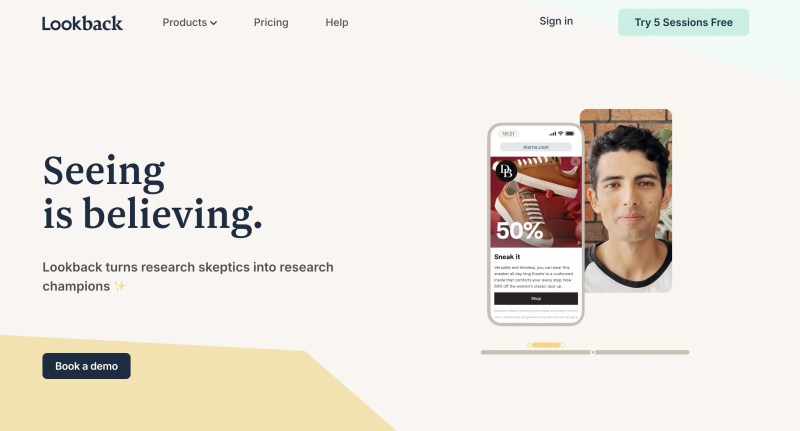
Lookback is a usability testing and user interview software that enables teams to conduct qualitative research. The platform captures the screen, face, and voice of research participants as they interact with digital experiences. Key features include remote observation, session highlighting, and integrations with recruitment platforms.
Pros:
- Real-time collaboration
- Flexible session formats
- Solid session recording and analysis tools
Cons:
- Steep learning curve (for some features)
- Occasional technical glitches
Reviews according to Capterra:
Overall score – 3.0/5
Ease of Use – 3.5/5
Customer Service – 2.1/5
Pricing:
Starts at $17 / month
16. Dovetail
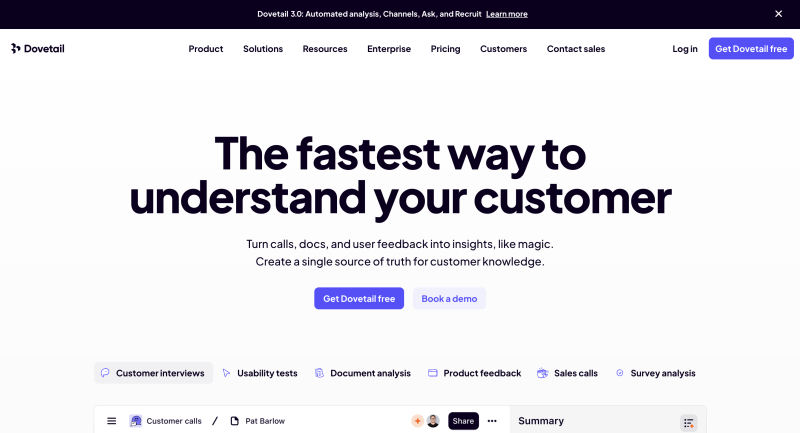
Dovetail is a user research and analysis platform designed to help teams organize, analyze, and share qualitative data from customer interviews, usability tests, and surveys. It enables users to centralize research data in one place, tag insights, create highlight reels, and organize findings into themes, making it easier to identify patterns and derive actionable insights.
Pros:
- Centralized research repository
- Powerful tagging and analysis tools
- Flexible visualization options
Cons:
- Limited quantitative analysis
- Steep learning curve (for advanced features)
Reviews according to Capterra:
Overall score – 4.5/5
Ease of Use – 4.6/5
Customer Service – 4.7/5
Pricing:
Free, professional starts at $29 / month
17. Survicate
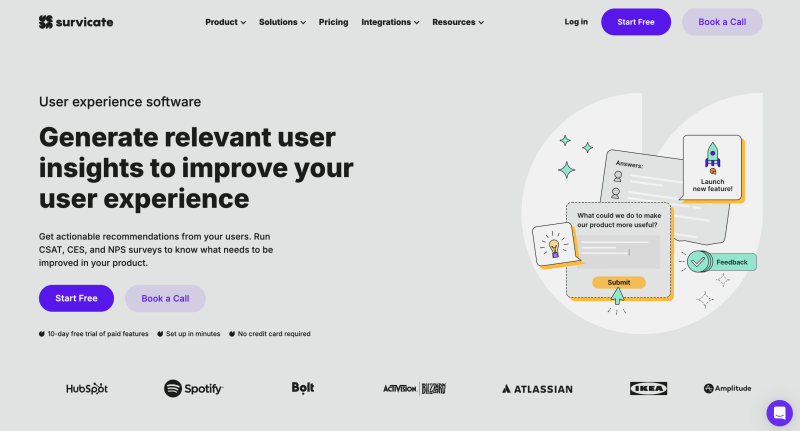
Survicate is a survey and feedback collection platform designed to gather and analyze customer insights across multiple channels, including websites, mobile apps, email, and chat. It enables businesses to create customizable surveys and feedback forms to understand user needs, improve product experiences, and drive customer satisfaction.
Pros:
- Versatile survey options
- Real-tiem insights
- Ease of use
Cons:
- Limited customization in free plan
- High complexity for beginners
Reviews according to Capterra:
Overall score – 4.6/5
Ease of Use – 4.6/5
Customer Service – 4.7/5
Pricing:
Free, paid version starts at $99 / month
18. Product Fruits
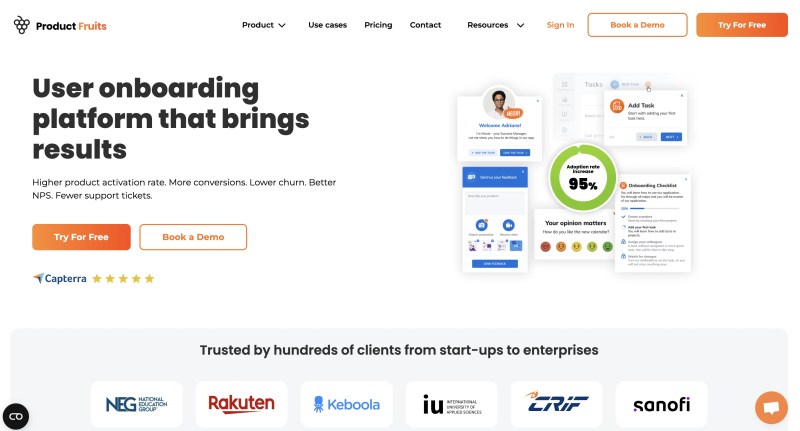
Product Fruits is a user onboarding and product adoption platform that enables businesses to guide new users through product features with in-app tutorials, tooltips, and checklists. It helps improve user engagement, drive feature adoption, and reduce churn by providing tailored experiences based on user needs.
Pros:
- Intuitive onboarding tools
- Provides analytics on user engagement
- Allows targeted messages and guides
- No coding required
Cons:
- Limited customization options (for basic plans)
- Steeper learning curve
Reviews according to Capterra:
Overall score – 4.7/5
Ease of Use – 4.6/5
Customer Service – 4.9/5
Pricing:
Starts at $99 / month
19. Optimal Workshop
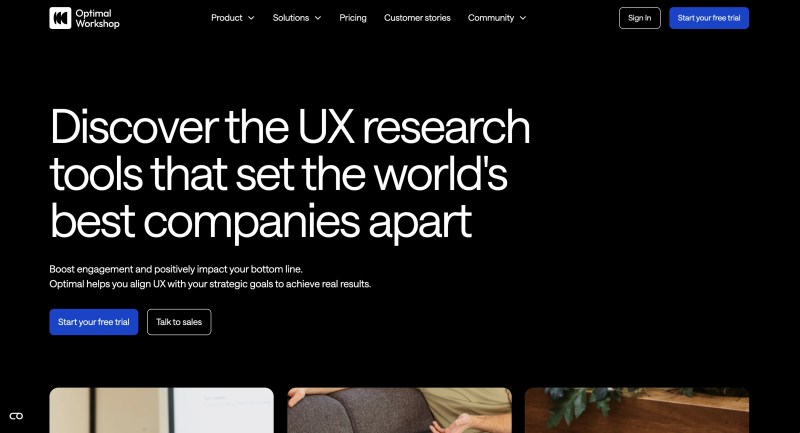
Optimal Workshop is a user research and usability testing platform that helps designers, UX researchers, and product teams better understand user behaviors, preferences, and interactions. It provides tools for tasks like card sorting, tree testing, surveys, and first-click testing, aiding in creating data-driven decisions for effective information architecture, navigation, and content structure.
Pros:
- Offers a range of usability testing options
- Collaborative capabilities
- Great data visualization
- Supports team collaboration
Cons:
- Limited customization in lower plans
- Steep learning curve for complex studies
- May be expensive for small teams
Reviews according to Capterra:
Overall score – 4.4/5
Ease of Use – 4.0/5
Customer Service – 5.0/5
Pricing:
Starts at $199 / month
20. Pendo
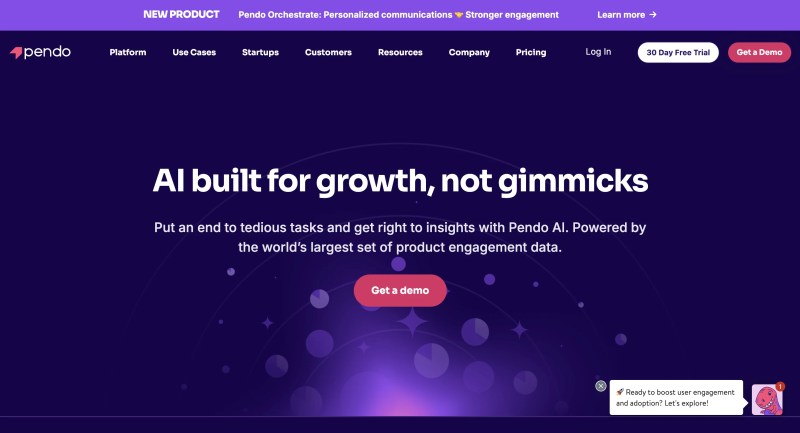
Pendo is a product experience platform that leverages AI to help businesses understand user behavior, enhance product adoption, and optimize user experiences. Its AI features include personalized product recommendations, predictive analytics, and automated feedback collection, allowing teams to tailor user experiences and identify areas for improvement.
Pros:
- In-depth analysis
- Enables personalized user experiences
- Provides AI-driven user segmentation
Cons:
- Unconventional pricing structure
- Integration challenges
Reviews according to Capterra:
Overall score – 4.5/5
Ease of Use – 4.1/5
Customer Service – 4.5/5
Pricing:
Free basic plan, custom pricing based on monthly active users (MAU)
21. UserZoom
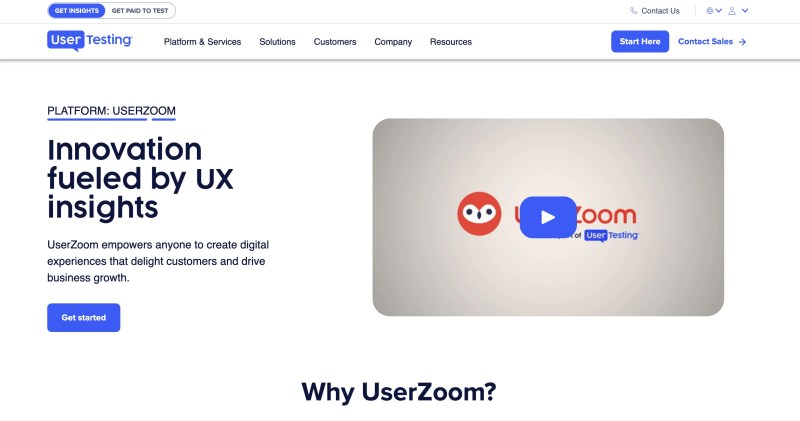
UserZoom is a comprehensive user experience (UX) research platform that incorporates artificial intelligence to enhance usability testing, user feedback analysis, and data insights. Its AI capabilities include automated insights generation, sentiment analysis, and predictive analytics, which help organizations quickly interpret user data, identify patterns, and make informed design decisions.
Pros:
- Provides robust research tools
- Suitable for teams of all sizes
- Designed for ease of use
Cons:
- Complexity for beginners
- Challenging to manage the volume of data
Reviews according to Capterra:
Overall score – 4.4/5
Ease of Use – 4.5/5
Customer Service – 4.7/5
Pricing:
Free trial, custom pricing structure
22. Startquestion
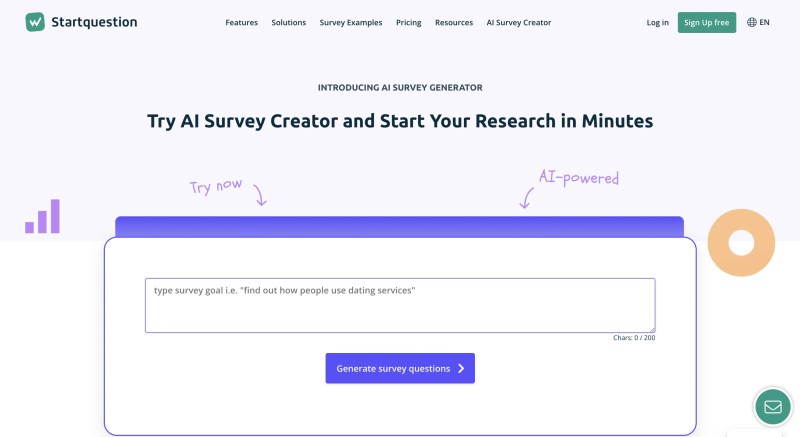
Startquestion is an AI-driven survey and research platform designed to streamline the process of gathering insights and feedback from users. It leverages artificial intelligence to create tailored surveys, analyze responses, and generate actionable insights. By automating aspects of survey design and data interpretation, StartQuestion helps organizations understand user preferences, improve products, and enhance customer experiences.
Pros:
- Highly customizable surveys
- Real-time feedback
- Features an intuitive design
Cons:
- Requires a stable internet connection
- Limited advanced features (for basic plans)
- Cost can be prohibitive for smaller businesses
Reviews according to Capterra:
Overall score – 4.9/5
Ease of Use – 4.8/5
Customer Service – 4.9/5
Pricing:
Free, paid version for businesses starts at $79 / month
23. EnjoyHQ
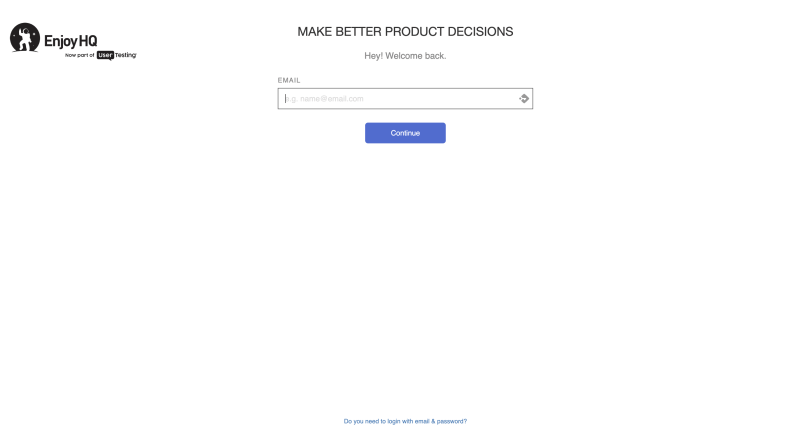
EnjoyHQ is a user research repository and insights management platform designed to help teams collect, organize, and analyze user feedback effectively. It incorporates some AI capabilities for tagging and categorizing user insights automatically, helping teams to streamline the process of understanding user needs and preferences from various data sources, including surveys, usability tests, and customer interviews.
Pros:
- Centralized knowledge repository
- Automated tagging
- Collaboration features
- Search functionality
Cons:
- Limited AI functionality (compared to competitors)
- Challenging learning curve for new users
Reviews according to Capterra:
Overall score – 4.8/5
Ease of Use – 4.3/5
Customer Service – 5.0/5
Pricing:
Free trial, paid version starts at $200 / month per feature
24. Smartlook
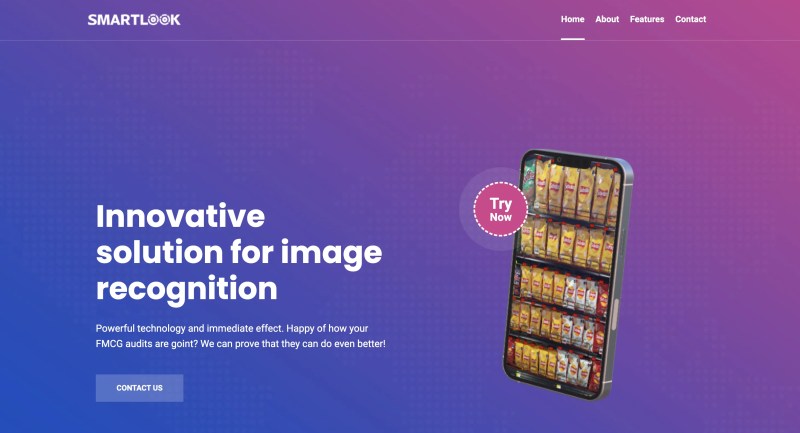
Smartlook is an analytics and user behavior tracking platform that utilizes AI to provide deep insights into user interactions with websites and mobile applications. It combines qualitative and quantitative data through features like session recordings, heatmaps, and event tracking to help teams understand how users engage with their digital products.
Pros:
- Offers a wide range of analytics tools
- Leverages AI to highlight user interactions
- Intuitive dashboard
- Integrates seamlessly with other analytics tools,
Cons:
- Overwhelming wealth of data
- Limited customization
Reviews according to Capterra:
Overall score – 4.7/5
Ease of Use – 4.7/5
Customer Service – 4.5/5
Pricing:
Free, paid version starts at $55 / month
25. Hotjar
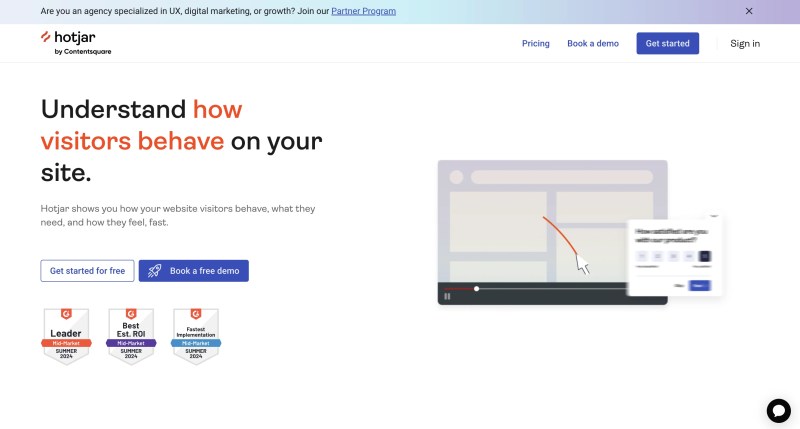
Hotjar is a powerful user analytics and feedback tool that offers insights into user behavior on websites. It provides features such as heatmaps, session recordings, and user feedback polls to help teams understand how visitors interact with their site. Iit utilizes advanced analytics techniques to aggregate user behavior data, enabling teams to make data-driven decisions.
Pros:
- User-friendly dashboard
- Provides a free basic plan
- Provides comprehensive user insights
Cons:
- Data privacy concerns
- Limited customization
- Performance issues with high traffic
Reviews according to Capterra:
Overall score – 4.7/5
Ease of Use – 4.6/5
Customer Service – 4.5/5
Pricing:
Free, paid version starts at $39 / month

There is a variety of factors worth considering when leveraging AI for UX research. To help you make an informed decision, think about whether the tool you’ve chosen ticks all the the right boxes. Here are the main areas to look for in your screening process:
Functionality – find out whether the tool specializes in specific tasks or offers a broad range of features. It’s generally advisable to opt for tools that excel in particular areas rather than those that promise extensive capabilities without proven performance.
Reviews and ratings – research user feedback to gauge the effectiveness and reliability of your chosen tool. High ratings and positive testimonials can indicate a trustworthy option.
Cost structure – analyze pricing models to understand what is included in free versions versus paid plans and ensure that costs remain manageable as your usage scales.
Output quality and accuracy – If possible, use free trials to assess the quality of outputs compared to your own work. This hands-on evaluation can help you determine if the solution meets your needs.
Curious about the topic of AI in UX research? Check out our conversation with Yao Adantor – a lead UX researcher at Research Bookmark! 🐝
Despite AI tools having a lot of benefits, they also have their respective problems, especially in UX research and related areas. One big problem is that the results aren’t always correct and need to be checked by a person, which can possibly take away from its time-saving benefits.
Additionally, AI lacks creativity and originality – relying on preexisting data and lacking the ability to understand or respond to human emotions, which is critical in UX design. It is also worth mentioning that the effectiveness of these tools also depends heavily on the quality of input data; poor data can lead to misleading results.
When augmenting your research with AI tools, keep these factors in mind. Knowing the risks associated with leveraging artificial intelligence can help you prevent skewed and inconsistent results after using them.

As the advancements in artificial intelligence increase, the landscape of UX research is rapidly evolving. These are the trends we’re seeing in the UX Research field in 2024 so far:
Using AI for Biometrics and Emotional Analysis – in order to measure physiological reactions like heart rate and eye movement during user interactions, biometric technologies are becoming more and more prevalent in UX. Automating it helps researchers better comprehend user emotions, which results in more sympathetic design solutions.
AR and VR – increasingly, augmented and virtual reality headsets are being utilized in UX research to create immersive testing environments. The use of this technology allows for richer insights into user interactions by simulating real-world scenarios, hence enhancing the overall research experience.
AI integration across the board – generally, using AI to analyze user behavior, automate data collection and even use AI participants to generate responses is rapidly increasing. This speaks to the transformational nature of this new technology and virtually all companies seeking to stay competitive use it to augment their services.
Ready to start using AI in UX research? UXtweak is here to help! 🐝


